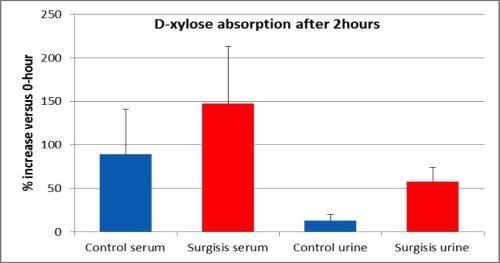|
|
Back to 2015 Annual Meeting Program Bio-Artificial Intestine: a Functional Study in Rats Tiziana Corsello*, Giuseppe Damiano, Massimiliano Tuveri, Mauro Montalbano, Cristiana Rastellini, Luca Cicalese Surgery, UTMB, Galveston, TX
Introduction. Short bowel syndrome is a condition caused by reduced intestinal length and insufficient absorption of nutrients. Total parenteral nutrition may improve life expectancy, but is potentially associated with severe complications and poor quality of life. Intestinal transplantation is potentially curative but its use is still limited by the requirement of potent immunosuppression, high rate of infections and shortage of optimal donors. A promising therapeutic approach consists in creating a bio-engineered segment of intestine. Using a decellularized biologic scaffold, we (and others) have previously developed a bio-artificial intestine that is morphologically similar to normal intestine. This neo-formed intestine is constructed with the intervention of naïve stem cells that repopulate the scaffold in vivo and over a period of time are transformed in different cell populations typical of normal intestinal mucosa. However, no studies are available to demonstrate that such intestinal segments possess functional characteristics necessary to render this strategy a possible therapeutic application. The Aim of this study was to demonstrate that the bio-engineered intestinal segment generated has functional absorptive capacity. Methods. Male ACI rats weighting 150-200g were used for the study. We transplanted 2cm sections of acellular matrix (Surgisis, Cook Medical, US) in the anti-mesenteric border of the jejunum and ileum of 11 rats. Animals were studied after 4, 8 and 12 weeks, and neo-formed intestinal tissue with near-normal mucosa was observed starting at 8 weeks post-implantation as expected from our previously developed model. We then isolated a segment of 2cm of intestine with preserved vascular supply and containing the neo-formed mucosa. This was compared to intestinal segments of 2cm isolated in the same location in un-operated control animals (n=6). D-Xylose solution was introduced in the lumen of the intestinal segments and 2 hours later urine and blood were collected to evaluate D-Xylose levels. Quantitative analysis was performed using Elisa. Body weight was monitored daily. Results. Surgery was well tolerated with good short and long-term survival (90% total). We observed an increased absorption (p<0.05) of D-xylose in the intestinal segment containing neo-formed mucosa as shown in the graph. Body weight increase was comparable to control un-operated animals. Conclusion. With this study, we demonstrated for the first time that bio-artificial intestine obtained from decellularized biologic scaffold has functional characteristics of absorption confirming its potential for therapeutic interventions. Back to 2015 Annual Meeting Program |
|||||||||
© 2026 Society for Surgery of the Alimentary Tract. All Rights Reserved. Read the Privacy Policy.


